Do you want to grow as a product owner and take new roles and responsibilities? There are several opportunities for you to pursue your dream career. The product owner career path consists of several jobs and roles that help you reach your destination.
If you are just starting and planning to grow yourself as a product owner, this detailed article will guide you in the right direction. You’ll learn the best roles and job titles that you can pursue in the product management cluster.
If you’re interested in learning more via video, then watch below. Otherwise, skip ahead.
Professor Rubik’s Brain Fitness, start training – ilvideogioco.com – cellicomsoft dianabol price 8 body positive fitness instagrammers that will inspire you to love your body – it.inspirationclassic.com
Let’s get started.
Understanding Product Owner Role
The product owner (PO) role might be confusing.
If you look at a few product owner open positions at LinkedIn, Glassdoor, and Indeed, you’ll notice a lot of differences in requirements, experience, skills, qualifications, and responsibilities.
Joshua Partogi explains in this video that product owner is a role and not a job title. This means the role can be assigned to anyone who has the highest authority on the product and this could be head of product, product manager, project manager, vice president of product, chief of product, etc.
So, whoever is at the highest level and owns the product (irrespective of job title), is a product owner. And this makes PO the highest-level role in the company and the product management career path.
A PO is responsible for maximizing product value, he/she owns the product, and is accountable for the product and everything related to it. He/she is responsible for complete the product and the role includes several tasks including:
- Product vision and defines product goals
- Backlog management and prioritization
- Communication and collaboration with key stakeholders
- Ensuring product backlog items are transparent and visible
- Communicating product backlog items to the scrum development team.
With these key responsibilities in mind, let’s explore the product owner career path.
Product Owner Career Path
Once you become a scrum product owner, you are in a decision-making position. You own a product in its full capacity so the career path ahead has more responsibilities and accountabilities.
Here is an overview of the career paths for product owners:
1. Senior Product Owner
Once you become a product owner, the most obvious career path is to become a senior product owner. Now, a senior PO isn’t a Scrum role so you’ll not find it in all types of organizations. Most large companies that work on large products and projects and usually split a product into different components and features create this role.
For example, a large company that’s working on a large product might split up the product into smaller manageable product parts. Each product component and/or feature has its own scrum team and PO. This is how multiple scrum teams work on a single large product.
In such a case, a senior product owner will manage all the product owners working on a single product. The senior PO will own the whole product and will be responsible for it.
Similarly, a senior PO role is needed when a company is working on multiple distinct products. There is a question in Scrum at Scale assessment related to such an instance:
Question: A multinational company, which has five major products, is using Scrum for product development. Which statements are the two best alternatives for how many Product Owners exist? (Choose 2.)
- A) As many as are needed to communicate expectations and requirements with Development Teams.
- B) One specific Product Owner is responsible for all five products. This Product Owner may delegate to others for specific value, capabilities, and functionality within each product.
- C) One and only one. The Product Owner may not delegate to others for specific value, capabilities, and functionality.
- D) One specific Product Owner is responsible for each product. This Product Owner may delegate to others for specific value, capabilities, and functionality within the product.
The correct answers are B and D, and this shows that a single PO can manage multiple products or a single PO can manage all the products and can delegate value and functionalities.
While a senior product owner might not be a role in small companies, large companies often have this role that is superior to PO.
If you’re interested in learning the skills to excel in a product owner role, then check out our product owner certification course.

2. Scrum Master
A scrum master is an advanced role that a PO can pursue. It is a defined role in the Scrum framework so it isn’t hard to find scrum master jobs. A scrum master has three main responsibilities:
- Scrum team management
- Working with the PO as advisor and coach
- Managing organizational tasks such as stakeholder education and guidance.
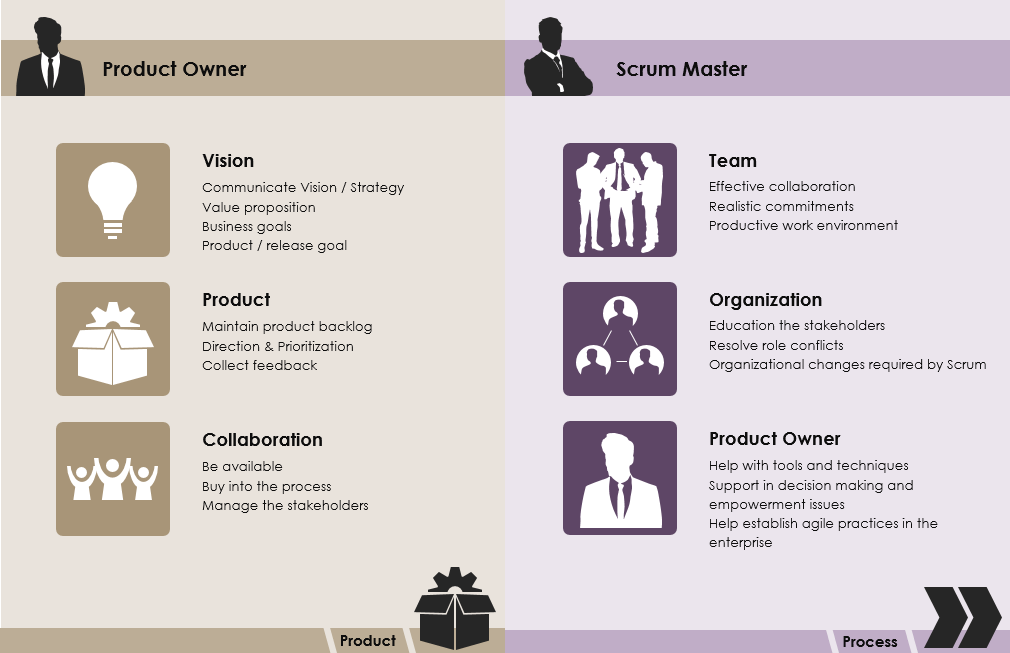
According to the Scrum Guides, the scrum master is accountable for the scrum team’s effectiveness that is done by helping the scrum team improve its practices. One of the key responsibilities of a scrum master is to help the product owner in finding techniques for product backlog management.
Ideally, a scrum master must have experience working as a product owner. You can’t become a scrum master if you have never worked as a PO. Why?
Because you must understand the PO role both theoretically and practically to advise and recommend a PO.
After spending a few good years as PO, your best bet is to switch to a scrum master role where you’ll be in a position to assist, guide, and mentor a PO. Besides, you’ll be interacting with the key stakeholders at the strategic level that includes leading, planning, advising, and training at the organizational level.
3. Portfolio Owner
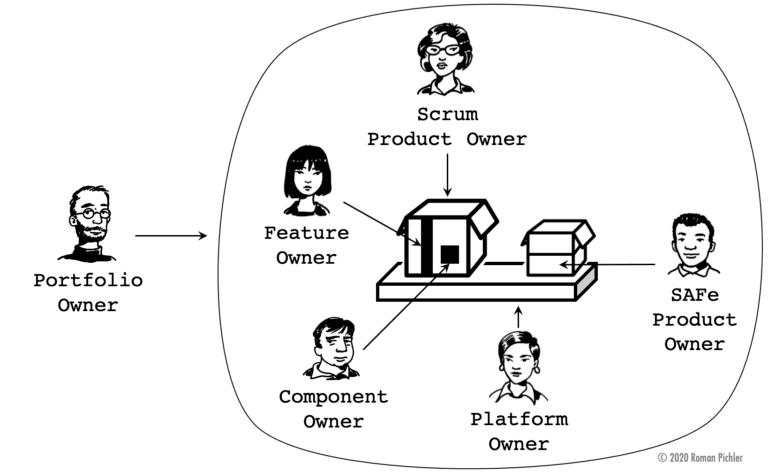
A portfolio owner or product portfolio manager is someone who owns and manages a group of related products. This is a role that you’ll often find with large organizations that work on multiple products, components, features, and platforms.
For example, Microsoft Office is a product portfolio that consists of Office products e.g. Word, Excel, PowerPoint, and others. Each Office product has its own product owner and then there is a portfolio owner who owns the full Office and is responsible for maximizing the value of the portfolio.
It is a natural transition from a product owner. After working as a product owner with multiple products in the same or different company, you’ll be in a nice position to manage a portfolio and multiple product owners.
The typical tasks of a product portfolio manager include:
- Managing the portfolio
- Collaborating with product owners
- Maximizing the value of the portfolio
- Managing product strategies and product goals
- Collaborating with stakeholders.
Managing a portfolio is a challenging role since you have to deal with product owners as well as agile teams of all the products. You’ll be dealing with a group of products and it requires both technical and interpersonal skills.
4. Product Manager
Despite all the debate and differences between product manager vs. product owner, one thing is clear: The product manager is a higher title/role than a product owner:
A product manager is someone who drives and manages the long-term strategy of the product(s) and isn’t just focused on value maximization. The position is more strategic and holistic in nature. A product manager is responsible for:
- Customer development
- Product development and project management
- Marketing
- Product vision and strategy
- Marketing and sales
- Product roadmap
- Pricing, competitor analysis, and market research.
However, a product manager isn’t a scrum role so technically, he/she has to be someone to whom a scrum master and product owner report. Scrum is just one portion of the gigantic product management responsibilities and tasks.
The product manager role is more of a management role as compared to the technical PO role. You’ll be responsible for product development, marketing, vision, and strategic objectives.
5. Product Director
A product director or director of product management is the role that manages and overlooks product managers in a company. In small organizations, you can become a product director right after the product owner or senior product owner. However, in larger organizations, you’ll have to become a product manager first and then a product director:
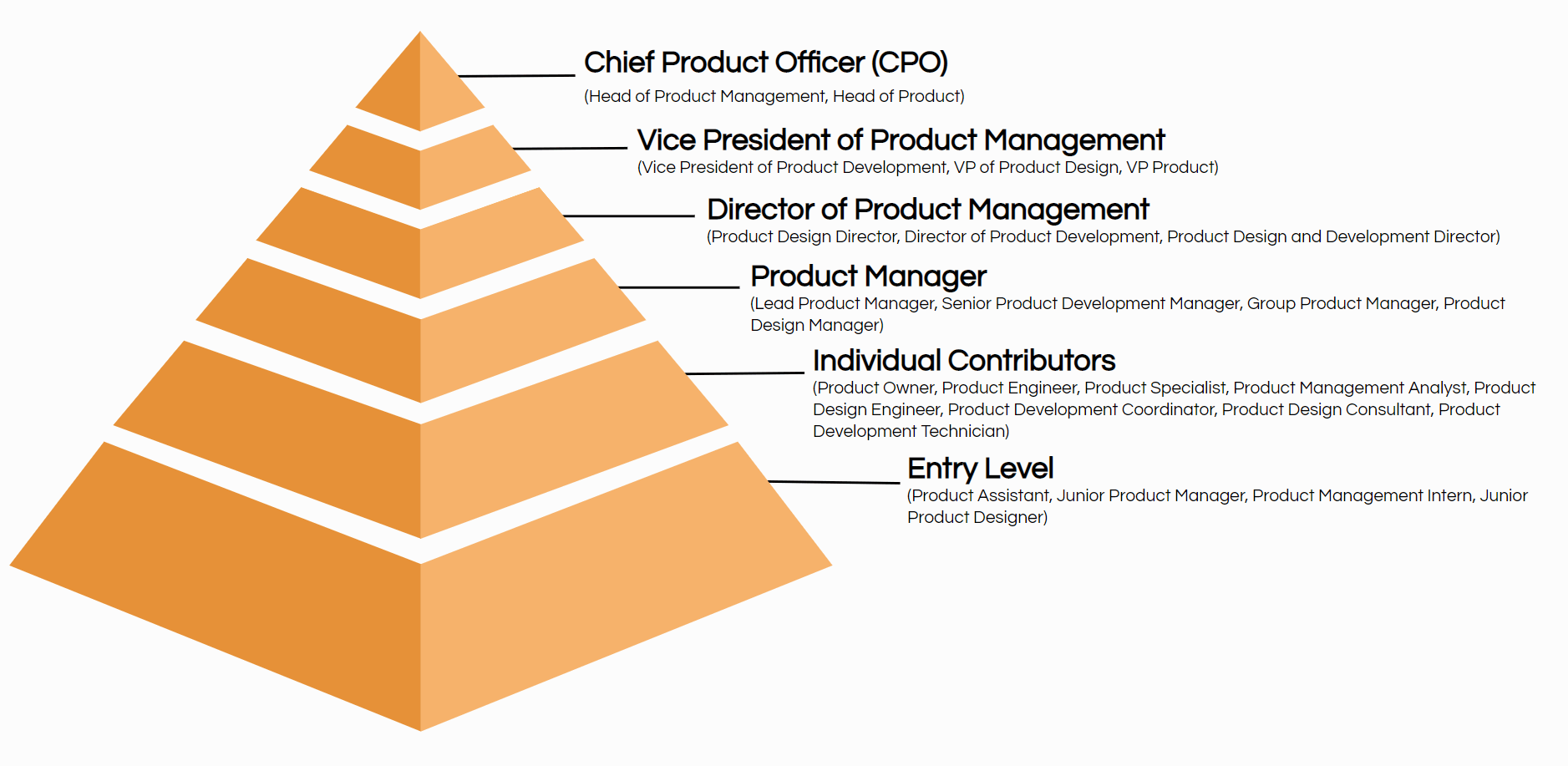
A product director is a senior management position that strategically manages all the products developed by the organization. Product managers report to the product director who then reports to the head of the product.
Here is a list of key tasks that a product director has to perform:
- Long-term product planning and strategy formulation
- Collaborate with seniors and subordinates
- Consulting and collaborating with stakeholders
- Product vision and proposal development and execution
- Product line lifecycle
- Marketing and consumer strategy.
There will be only a single product director in an organization who overlooks all the products. Since it is a leadership role, therefore, most of the time is spent on leading, planning, and controlling.
6. Head of Product
Head of product or vice president product or chief product officer is a higher management corporate role that is responsible for all the products in the organization. Depending on the size of the organization and the number of products that it owns, an organization can use different titles such as head of product, VP product, chief product officer, or a similar title.
It is the highest management level in an organization that a PO can aim for.
For small organizations, product managers or product owners directly report to the VP product:
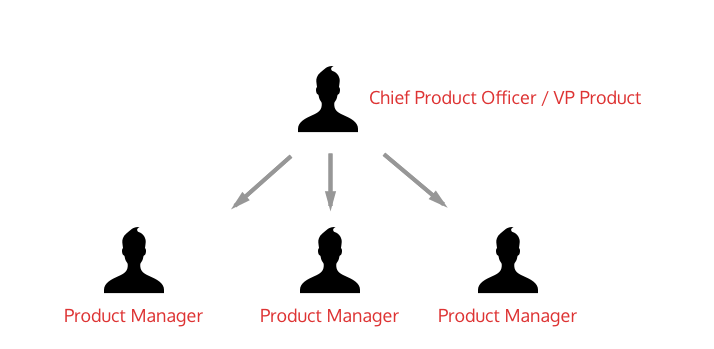
In large organizations that have product directors who report to the head of product:
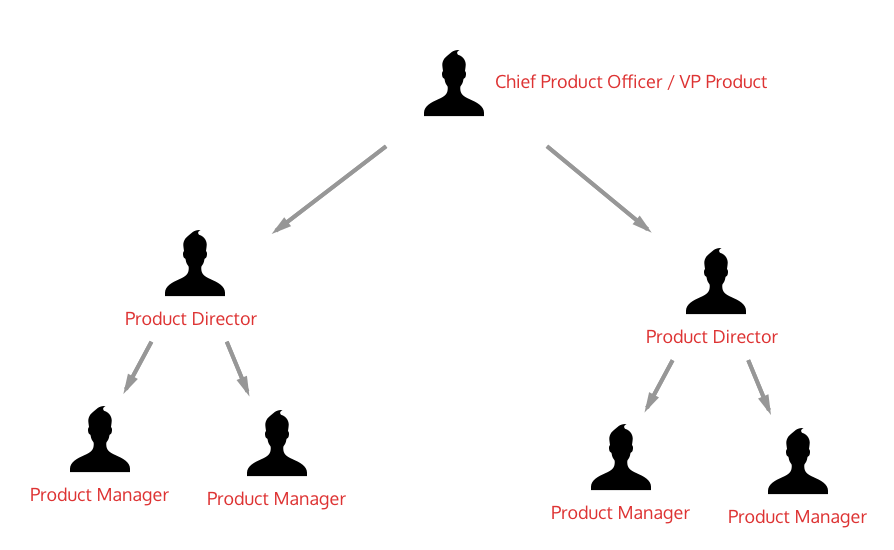
A fairly large organization that has multiple products, portfolios, and heads (e.g. Microsoft), a chief product officer overlooks everything in the product department, and sits at the top position in the department:
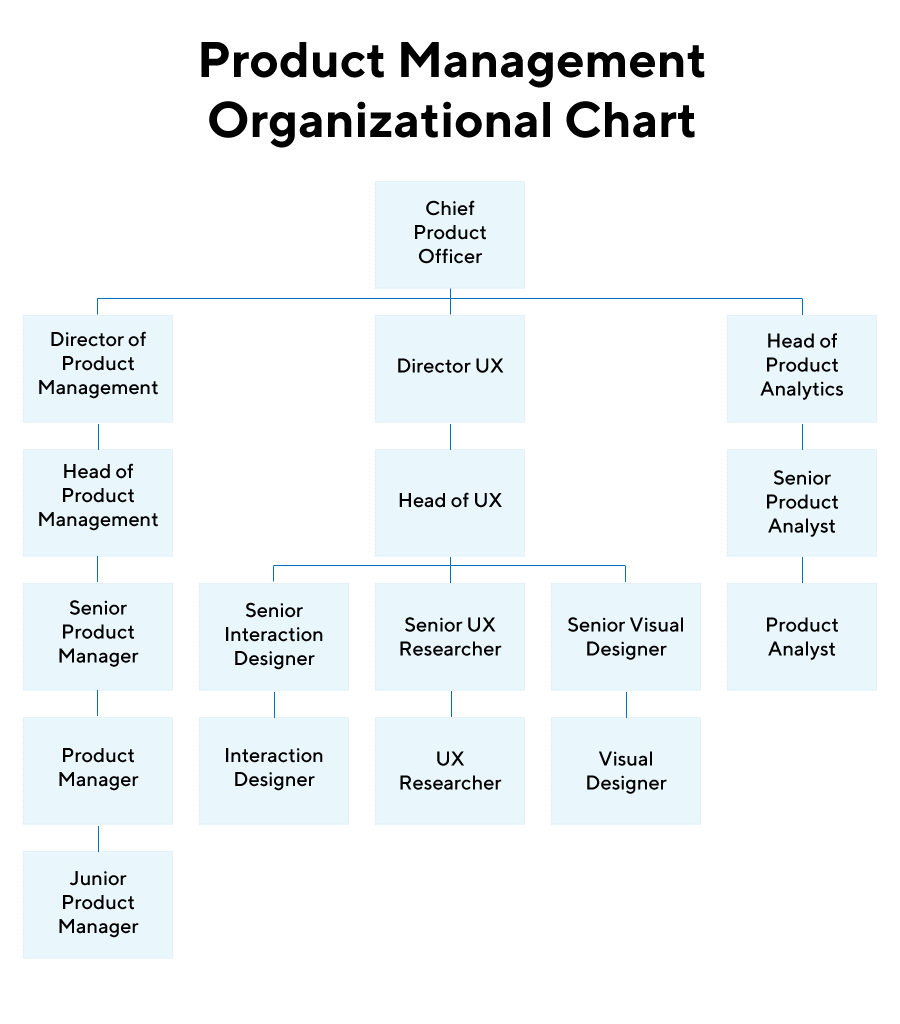
So, if you are in a small organization, you’ll be managing and dealing with a few product managers directly. And if you are in a large organization, you’ll be managing product directors who will be managing product managers.
As a chief product officer, you’ll be responsible for:
- Managing all the products
- Setting overall product strategic goals
- Product strategy, resource allocation, and recruitment
- Managing product owners, product managers, and product directors
- Mentoring and coaching
- Ensuring that overall product goals are met.
7. Other Career Paths
Where do you go from chief product officer? Well, there are several other options once you reach the highest level in an organization:
- Chief executive officer is the most ideal job title that you can aim for once you have spent a decent time as product head
- You can become an entrepreneur and start your own development company
- Consultation and speaking are the best career paths if you don’t want to start your own company
- If you have earned enough, you can become a venture capitalist. Or, you can simply become an angel investor and start funding software development companies based on your experience.
Be an Awesome Product Owner
The product owner career path is full of opportunities. There are tons of growth opportunities. You must give your 100% throughout your career to become a great leader.
It is essential to decide your career path right now when you are a product owner or a junior business analyst. Decide what you want to become after 10 years and then start acquiring appropriate skills and experience.
For example, if you are aiming to start your software development company after a few years. You must switch roles quickly. Try gaining experience throughout the product management hierarchy so that you know what to expect when you start your own company. Work with small companies where you can become a product manager and then head of product and acquire necessary skills.
The product owner job is a great career choice. You need to plan early for growth.
